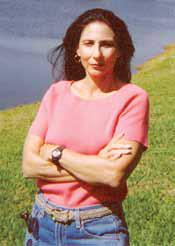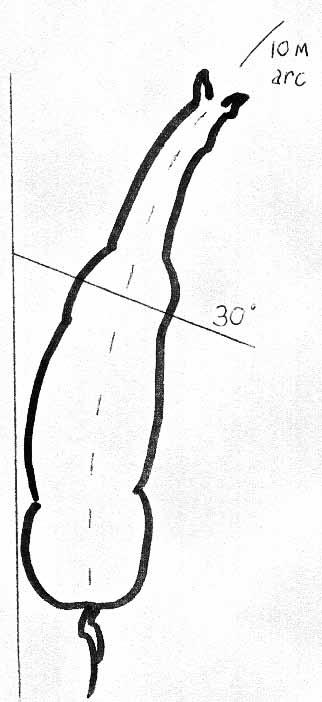This is a SEO version of 2302_full. Click here to view full version
« Previous Page Table of Contents Next Page »20 SIDELINES FEBRUARY 2011 FOR HORSE PEOPLE • ABOUT HORSE PEOPLE H O R S E I N M O T I O N
By Dr. Beverly Gordon
I have found that beginning shoulder-in exercises opens up a whole maze of confusion for both horse and rider. Prior to this experience, both horses and riders have traveled along straight lines where their bodies have moved as a single unit, with everything facing forward in the direction they are moving. The horse’s hind end follows the path of his head, neck and shoulders.
Now we introduce the shoulder-in. The horse’s hind end still tracks straight, but unlike before, now he has to move along a straight line with the front of his body and his head pointing inward. Essentially, here the horse has to learn
not to follow his head, neck and shoulders. To add to this dilemma, the horse now has to adapt to the feeling that his front end is traveling sideways while his hind end is tracking straight.
The horse is not alone in this confusing endeavor. Likewise for the rider, their shoulder position will be at the same inward angle as the horse’s shoulders. And just like the horse, the rider’s pelvis will remain facing forward, tracking straight along the track.
The “3” Basic Pitfalls
With an inexperienced rider, or green horse, we can expect to see some (or all) of these basic pitfalls. With a more experienced horse and rider, these pitfalls should
never occur.
1- Horse moves along the track with his body straight but his head and neck turned to the inside. 2- Horse swings his haunches out to get into the “shoulder-in” position and ends up leg yielding along the track (on 4 tracks instead of 3) with a straight spine and no body bend.
3- Horse will try to follow his head and neck and move away from the track toward the inside of the arena.
Many shoulder-in performance issues occur as the result of the rider using too much inside rein, not enough lateral direction, and insuffcient support from the inside leg. Less experienced riders often use their inside leg too far behind the girth, or tense their body and forget to use weight aids to direct the horse along the track, or fail to keep their upper body turned and their pelvis straight. So, now that you know what not to do, let’s talk about what you should do to get a good, correctly trained shoulder-in.
Schooling the Shoulder-in

Schooling a Correct Shoulder-in
A correctly ridden shoulder-in is a pleasure to watch. The horse will be moving with his shoulders to the inside, bent around the rider’s inside leg, with his inside hind leg following in the track of his outside foreleg. The horse will travel on three tracks instead of four. His weight will be shifted toward his hindquarters and he will move forward freely with a lightened forehand in an appropriately round frame.
Specifcally, the horse’s shoulders angle away from the track at about 30 degrees, and his bend will be similar to his body position on a 10 meter circle.
Proper schooling of the shoulder-in sets up a solid foundation for all training, since this skill gives the horse the foundation to develop greater suppleness, balance, strength, fexibility, and connection. Unfortunately, improperly schooling the shoulder-in can easily produce undesired effects such as resistances,
crookedness, and unsoundness, to name a few. Therefore, the shoulder-in is not only an important skill to include in your training program, but it is essential that you school it correctly.
In order to do this, you need to understand the correct aids.

Seat and weight : your shoulders should be turned slightly to the inside at the same angle as your horse’s shoulders. Do not twist your pelvis- it should remain on the same angle as your horse’s pelvis. Make sure your inside seat bone is weighted enough to bend the horse and your outside seat bone in not blocking his movement down the track. You should be looking in the direction you are going.
Bridle : your reins will help assist the horse’s position and direction. Your outside rein supports the horse’s shoulder and your inside rein encourages your horse to stay softly fexed toward the inside . Do not pull on the horse’s head in using the inside rein.
Legs : use your inside leg at the girth to direct your horse’s movement along the track. Your leg is slightly behind the girth, passively keeping the haunches from swinging out. As you come out of the corner , allow your horse’s forehand to leave the track as if you were beginning to ride a circle. The moment you feel the forehand begin to leave the track, simultaneously support the horse on
Dr. Beverly Gordon is both a licensed human and certifed AVCA animal chiropractor, consultant at L.I.Equine Med Center, and President of Gordon Chiropractic. Her background is in exercise physiology and biomechanics of movement. Dr. Gordon’s practice is limited to horses and focuses on improving movement and performance at all levels through grand prix. She may be contacted at thehorseinmotion@aol.com or 516-606-4141.
Continued on next page
This is a SEO version of 2302_full. Click here to view full version
« Previous Page Table of Contents Next Page »